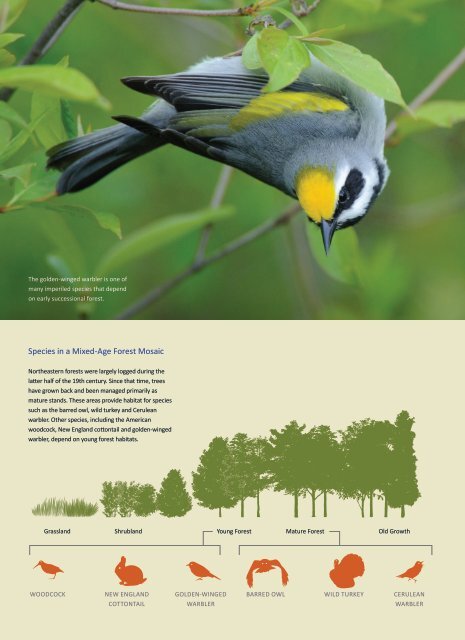NATIONAL FISH AND WILDLIFE FOUNDATION
2015_annual_report
2015_annual_report
Create successful ePaper yourself
Turn your PDF publications into a flip-book with our unique Google optimized e-Paper software.
RESTORING <strong>AND</strong> MANAGING<br />
DIVERSE EASTERN FORESTS<br />
Aerial images of the Northeast and Great Lakes regions sometimes<br />
paint a simple view of forest health.<br />
Such photographs often show rolling hills and mountains covered in a carpet of green<br />
canopy. To the untrained eye, this appears to be a healthy forest ecosystem. But to<br />
biologists fighting to reverse a staggering decline in the abundance of key species, such<br />
uniformity can signal trouble.<br />
“Healthy forest systems include a mosaic of habitats, including grasslands, wetlands, thick<br />
patches of young forest and open stands of old growth,” said Tony Ferguson, the U.S. Forest<br />
Service’s director of the northeastern area state and private forestry. “Species often depend<br />
on different forest habitats at different stages in their life cycles, and some species are<br />
primarily found only in a particular age-class of forest.<br />
The golden-winged warbler is one of<br />
many imperiled species that depend<br />
on early successional forest.<br />
Species in a Mixed-Age Forest Mosaic<br />
Northeastern forests were largely logged during the<br />
latter half of the 19th century. Since that time, trees<br />
have grown back and been managed primarily as<br />
mature stands. These areas provide habitat for species<br />
such as the barred owl, wild turkey and Cerulean<br />
warbler. Other species, including the American<br />
woodcock, New England cottontail and golden-winged<br />
warbler, depend on young forest habitats.<br />
“When large expanses of forested landscape aren’t managed with biodiversity as a goal, we<br />
start to see a dramatic decline in many species. We like to help landowners understand the<br />
benefits of managing forested habitats for a suite of game and non-game species.”<br />
In the Great Lakes and Northeast regions, some<br />
Healthy forest systems include a mosaic of conservation efforts focus on creating and<br />
managing for early successional forest areas —<br />
habitats, including grasslands, wetlands, thick patches<br />
tangles of shrubs and young trees and patches<br />
of young forest and open stands of old growth. of annuals and perennials that would naturally<br />
spring up following wildfires, storms and other<br />
— Tony Ferguson, U.S. Department of Agriculture, U.S. Forest Service<br />
disturbances. These young forest patches<br />
serve as critical breeding and nesting habitats<br />
for a number of declining bird species, including the golden-winged warbler and American<br />
woodcock. Other imperiled species, including the New England cottontail, depend on such<br />
habitats throughout their life cycles.<br />
Despite their importance to forest health and biodiversity, young forests have in many places<br />
been replaced by stands of uniformally aged trees.<br />
For nearly a decade, NFWF’s Early Successional Forest Initiative has provided critical support<br />
to organizations working with large and small landowners to create and manage young forests.<br />
In 2015, the U.S. Department of the Interior recognized NFWF for its role in helping<br />
landowners in the Northeast reverse a dramatic decline in the population of the New England<br />
cottontail, which had been considered for listing under the Endangered Species Act.<br />
37<br />
Grassland<br />
Shrubland Young Forest Mature Forest Old Growth<br />
Building on this conservation success, NFWF launched the New England Forest and Rivers<br />
Fund in 2015. This new competitive grant program focuses on diverse healthy forest systems<br />
and rivers, along with the species and human communities that depend on them.<br />
WOODCOCK<br />
NEW ENGL<strong>AND</strong><br />
COTTONTAIL<br />
GOLDEN-WINGED<br />
WARBLER<br />
BARRED OWL WILD TURKEY CERULEAN<br />
WARBLER<br />
CONTRIBUTING PARTNERS U.S. Department of the Interior’s U.S. Fish and Wildlife<br />
Service; U.S. Department of Agriculture’s U.S. Forest Service, and Natural Resources<br />
Conservation Service; and Eversource


